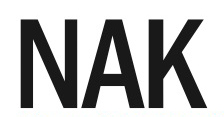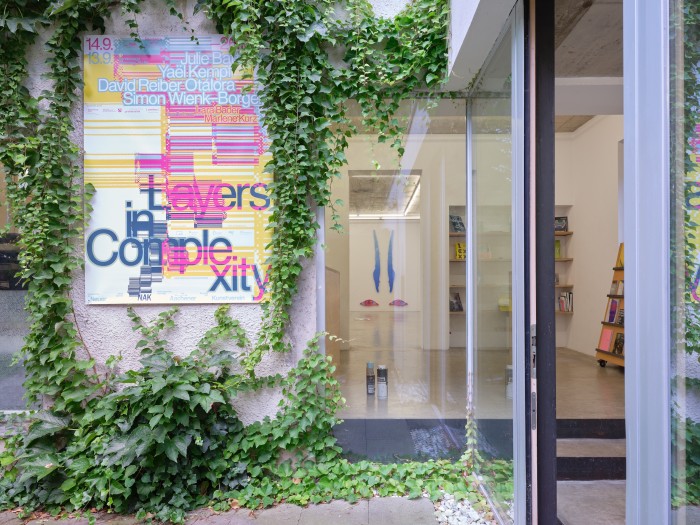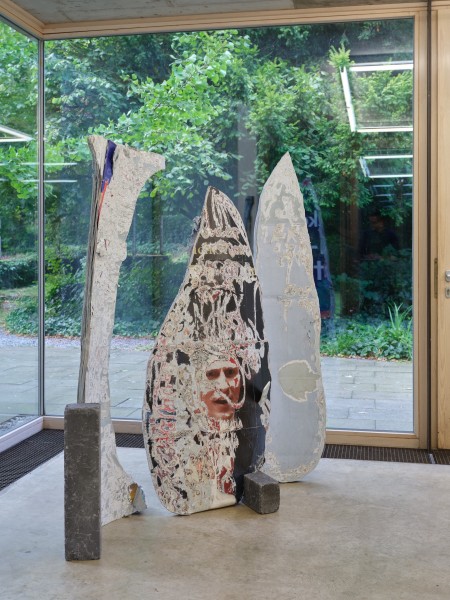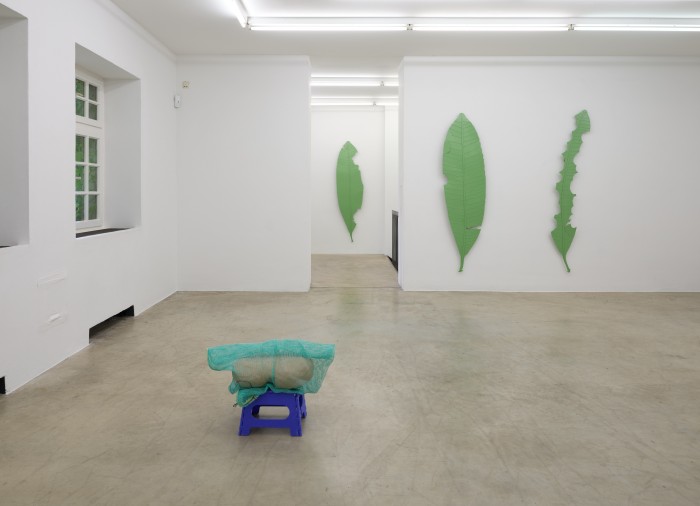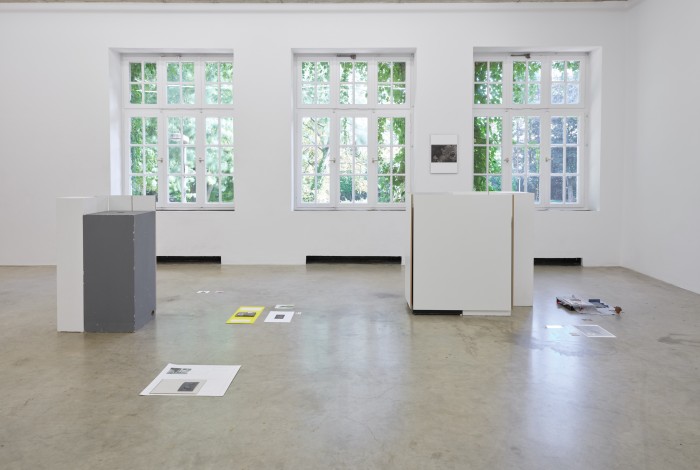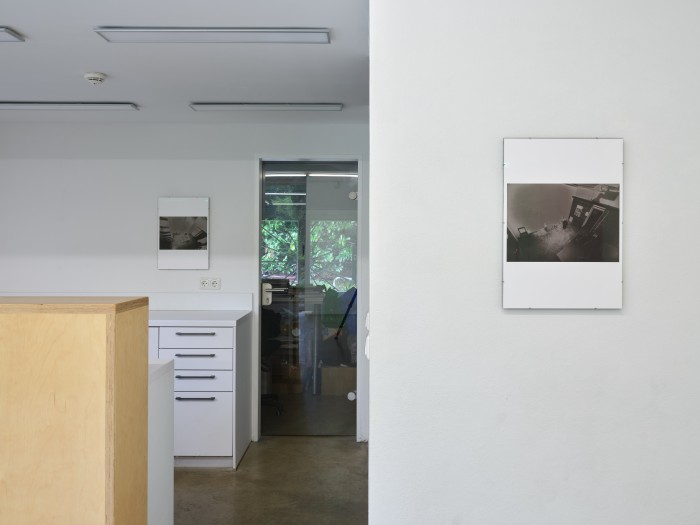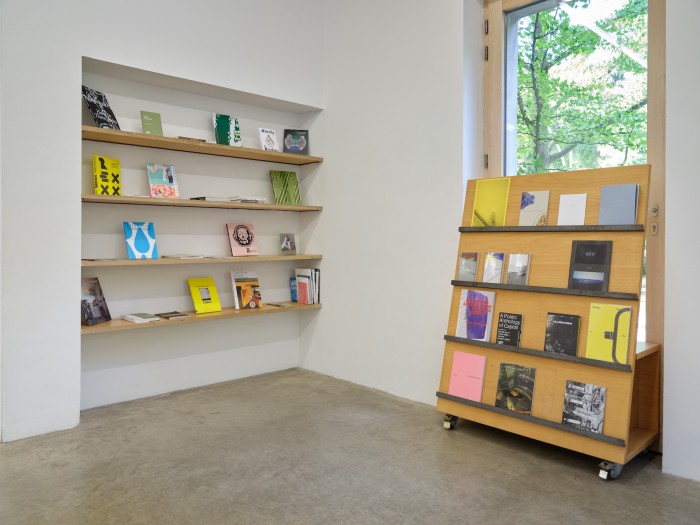Layers in Complexity
Julie Batteux, Yaël Kempf, David Reiber Otálora, Simon Wienk-Borgert
OPENING:
Saturday 13 September 2025
7 — 11 PM
OPEN:
14 September
—
26 October 2025
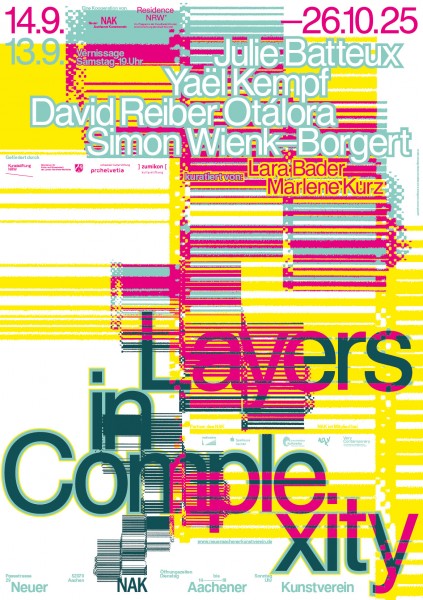
Layers in Complexity
With: Julie Batteux, Yaël Kempf, David Reiber Otálora, Simon Wienk-Borgert
Curated by Lara Bader and Marlene Kurz
NAK Neuer Aachener Kunstverein and the Residence NRW⁺ cordially invite you to the opening of the exhibition Layers in Complexity on Saturday, 13 September 2025, at 7 pm.
From 14 September to 26 October 2025, the artists Julie Batteux, Yaël Kempf, David Reiber Otálora and Simon Wienk-Borgert will present current works created during their one-year scholarship period (2024/2025) at the residency in Münster. The exhibition is curated by Lara Bader and Marlene Kurz, who are curators of the programme from April to September 2025. Every year, the NRW⁺residency brings together a juried, diverse group of artists and curators – with different backgrounds, approaches, and thematic references.
The title Layers in Complexity is an invitation by the two curators to explore the exhibited works through the idea and concept of layers. Layering thrives on the plurality of individual elements and their relationships to one another – a quality evident not only within the individual works, but also in the nature of the fellowship programme. Although the artists share a living space, their artistic work follows its own paths and not a common theme. Layers in Complexity is inspired by the philosopher Donna Haraway’s metaphor of onion layers: an onion has no fixed core but consists solely of its layers. Haraway illustrates that knowledge and interpretation are always context-dependent, multi-layered, and never final. Any insight thus remains limited, situational, and in flux – Haraway’s image makes multidimensionality visible. This also reflects the initial concept of the residency, where different artistic and curatorial positions coexist and the focus lies on open, situational exchange.
Thinking about layering can make the processes of creation and thematic overlaps tangible, as well as differences and gaps within the works. In the works, which range from figurative painting, photography, installations, sculptures, collages to video, these overlaps emerge as conceptual, material, temporal, and thematic strategies. The artists explore material layers – such as layers of posters in the sculptural works of Yaël Kempf, glazed layers of paint in the works of Julie Batteux, and paper collages by David Reiber Otálora – to layers of different logics in the works of Simon Wienk-Borgert. Engaging with multiple metaphorical layers through their motifs, the works open up complex art-historical references, personal memories, and connections between material, spaces and time, both within each work and in dialog with one another.
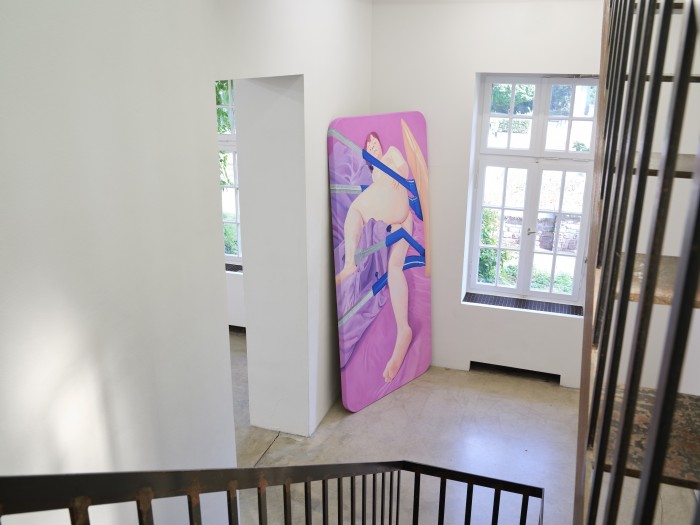
Referring to the paintings of Julie Batteux, the term layers points to her painting technique: her works emerge through glazed layers of paint, which interweave in a multi-layered way with the striking shape of the canvas and the dense imagery. A complex image structure unfolds that only reveals itself upon closer inspection – not only within the individual works, but also in the Schattenbock(sen) series and in dialogue with the viewers as well as with the other works in the space. The starting point of many of her series is the naked female body, which in the Schattenbock(sen) series, as in others, is always her own. She shows her body in provocative poses, sometimes from mercilessly strong low angles, but also kneeling frontally facing the viewers, gazing at them sometimes challengingly, sometimes appraisingly. Standing in front of the images, we assume the camera’s perspective, and thus perceive the self-reflective, but also self-forgetful gaze of the protagonist in confrontation with the selfie camera. Body images, the relationship to one’s own sexuality, and objects of desire are staged here. The autobiographical object of fear from sports class in school, the vaulting horse, is partially reversed, as it seems to merge with the body almost like in an act of love, becomes the support for it, or enters into conflict with it. Within the series, the German expression “Bock haben” a synonym for “to feel like” or “to desire” unfolds in a multi-layered way and is extended by the connotation of the rebellious, stubborn animal goat [Ger.: Bock]. By staging vulnerability, anger, and resilience on the one hand, and pleasure, self-confidence, and self-empowerment on the other, Batteux develops a sensitive, autobiographically influenced examination of the female body, its attributions and evaluations.
In the foyer of the Kunstverein, visitors encounter the installation Problem of God by Yaël Kempf. The sculptures consist of thick layers of former poster walls found on the street, whose milled, bark-like surfaces reveal fragments of past advertising messages. These remnants of consumption and the urban landscape, detached from their original purpose, become raw sediments of a contemporary urbanity. Standing archaically in the space, the forms resemble sharply struck flint tools from the Stone Age. Between the layers, an iPhone is embedded, playing a video that refers to the film on the upper floor, in which the suggested narrative continues. There, a bench made of the same layered material invites visitors to linger. Mushrooms grow from it, like on a felled tree. It forms the starting point for the short film, in which mythical images meet a brittle, post-industrial urban landscape. Together with a group of young people from the Glückauf School in Essen, the video was created based on an improvised scene script that transforms their living environments and fantasies into poetic fictions. It was filmed on the grounds surrounding Richard Serra’s monumental sculpture Bramme, located on a former mining dump in the north of Essen. The relic of a coal mining becomes the backdrop for their story. In wide shots, the young people run over huge pipelines, the camera movements are reminiscent of the free dynamics of open video game worlds. In other scenes, they play soccer, filmed from a player’s perspective, so that the boundary between digital aesthetics and real presence oscillates. A feeling of summer, youth, freedom, and inertia emerges, interspersed with thoughts of the future. Scenes merge into a state of lightness and uncertainty. Violence, crime, and unspoken desires flash up – the young people drift between past, present, and new possibilities
David Reiber Otálora‘s artistic work investigates the impacts of colonialism that continue to affect society today. He is particularly interested in the tropics, their exoticist representation and exploitation, but also in the question of how common Western perspectives can be questioned and expanded through new, alternative viewpoints. Green, oversized plant leaves made of metal hanging on the wall play with the Western tradition of using tropical plants and their motifs as purely decorative elements. The viewer’s gaze is directed to the form, the material, and the size of the leaf. But only the knowledge that this is an enlarged representation of real models from nature, showing damage caused by leafcutter ants whose colonies are mainly found in the South American rainforest, opens up another dimension of the work. Reiber Otálora is interested in the production aesthetics of nature, as shown in the cutting traces of the ants on the leaves. The decision-making process of these insects resembles Reiber Otálora’s artistic approach, especially in his collages, which can be seen on the first floor of the exhibition. Here he processes copies of scientific text excerpts and schematic drawings from essays like Plant chimeras: The good, the bad, and the ‘Bizzaria’ (Margaret H. Frank, Daniel H. Chitwood, 2016) as well as photographs from online forums dealing with the technique of plant grafting – the joining of two plants so that they grow together. Reiber Otálora sews these materials into large-format collages. Similar to the botanical technique itself, multilayered image surfaces emerge: leaf elements are cut out – as by the ants -reveal other layers and join together to form new shapes that can be infinitely expanded.
The photographic series Emotional Budgets by Simon Wienk-Borgert captures interior rooms from an elevated perspective, similar to a surveillance camera. He directs this observing gaze to his own studio in Düsseldorf, a multifunctional place: a former greengrocer’s shop that has evolved into an artist-run exhibition space, studio, and living space. This can also be read as a reference to Residence NRW⁺, where work and living spaces merge. The inverted black-and-white photographs reverse everyday spaces: light becomes dark, private becomes public, shop architecture becomes exhibition display. Architectural, social, and emotional boundaries emerge and are renegotiated in an overlaid space between production, exhibition, and everyday life. This is also evident in the placement in the exhibition, where the works extend into the office of the Neuer Aachener Kunstverein – a transitional and passageway space.
With pedestals and window coverings from the Kunstverein’s inventory as well as other material, Wienk-Borgert develops the installation Untitled Constellation, whose elements are arranged on site. He collects, dismantles, and condenses his own and external materials in a temporary installation. The arrangement follows neither a hierarchical logic nor a clear narrative, but creates a visual, net-like structure. Books of different genres – such as an instruction manual or a collection of botanical illustrations – meet publications such as A Man Asleep (Georges Perec, 1991) or Pamphlet Architecture 28: Augmented Landscapes (2006), which refer to the nature, history, and instability of spaces. Untitled Constellation unites the objects into a field of tension that allows for sometimes familiar, sometimes irritating combinations and associative or ambiguous connections and references.
Layers in Complexity – Between Traces and Sediments
While exploring the theme of layers, questions about overlaps and traces within the long-standing scholarship program Residence NRW+ emerged. Initially based at Schloss Ringenberg for nearly 20 years as a German-Dutch cooperation project, the program moved to Münster in 2018. In 2020/2021, the newly restructured residency program was launched there – for the first time institutionally linked to Kunsthalle Münster and with the Swiss cultural foundation Pro Helvetia as new international funding partner. In addition to some furniture from the old residency program, books in particular have moved to the new location – silent witnesses to artistic and curatorial practice, reflection, and research.
The publications sent in by former scholarship holders now form a separate layer within the curatorial concept and refer to the continuity and complexity of the program. As material and content-related traces, they document not only individual artistic developments, but also the collective history of the residency program. The selection includes publications from various disciplines – from artistic monographs to curatorial essays to experimental formats – and opens up a multifaceted archive. The books are embedded as a separate exhibition within the spatial and thematic structure of this year’s scholarship exhibition. They represent the connection between production and reflection, the layers between idea, implementation, and memory. In this way, the exhibition becomes a place where past and present overlap and new perspectives on the program and its impact emerge.
The exhibition is part of Residence NRW⁺, a fellowship programme for artists and curators. Residence NRW⁺ is a program of the Kunsthalle Münster, an institution of the City of Münster. www.residencenrw.de
Short biographies
Julie Batteux (born 1996 in Aachen) studied at the Academy of Fine Arts Nuremberg from 2014 to 2022, among others with Prof. Susanne Kühn and Prof. Jürgen Teller. Her project Spiegelschatten was awarded the graduate prize. Julie Batteux’s paintings primarily explore the aesthetic guiding cultures of social networks in relation to body images and their impact on the psyche of the user. She has participated in various group exhibitions, among other at the Kunstpavillon München and the Kunstmuseum Erlangen. In 2023, she presented her first solo exhibition Leibeigen at the Kunstverein Kohlenhof, followed in 2025 by the exhibition Safer Space at the Kunstmuseum Heidenheim. Her work has received several awards, including the Förderpreis des Bezirks Mittelfranken, the Bayrischer Kunstförderpreis, and the Bayerische Atelierpreis.
Yaël Kempf (born in Geneva) is a French artist. She completed her studies at the Düsseldorf Art Academy in 2020, where she currently lives and works. Her film and sculptural works combine poetic strategies with political research, revolving around questions of migration, ecology, and identity. In 2022, she deepened this focus during a residency from the NRW Art Foundation in Tel Aviv. In 2024, she presented her solo exhibition Annunciation at the Kunsthaus Essen and received support from the Visuelle Kunst Junge Szene program for La Faim du Tigre. In 2023, she was awarded the Deutsche Bank Atelier-Stipendium. Her works have recently been shown at Museum Ludwig (Cologne), Kai 10 | Arthena Foundation (Düsseldorf), Weltkunstzimmer (Düsseldorf), and Villa du Parc (Annemasse), among others.
David Reiber Otálora (born 1992 in Münster) completed his studies at HFBK Hamburg in 2020 and now lives and works in Berlin. His artistic practice engages with the many afterlives of colonialism, particularly as they inform the representation, imaginary and ongoing destruction of the tropics. Through atmospherically dense and speculative works, Reiber Otálora resists the epistemic violence of a world reduced to the real. He had his first solo exhibition Tropical Frenzy at Kunstverein Gießen in 2019 and has participated in various group exhibitions, most recently at Britzenale 5 in Berlin, as well as in 2024 at the Dortmunder Kunstverein, Hamburger Kunstverein, Klosterruine Berlin, and with Urbane Künste Ruhr.
Simon Wienk-Borgert (born 1988 in Baden-Baden) completed his studies at the Düsseldorf Art Academy in 2023 and lives and works in Düsseldorf. In his artistic practice, he develops a responsive archive of time-based work fragments and invariants through an ongoing process of collecting, decomposing and densifying own and third-party materials. Since 2018, he has explored his own involvement and the parameters of what art can be for him within exhibition formats. Most recently, he published visualsnow (2023), the first edition in his own publishing house SOLBATEMIM (together with Johanna Terhechte and Ludwig Kuffer). Since 2024 Simon Wienk-Borgert has been part of the artist-run space Linienstrasse in Düsseldorf.
A cooperation of:
 Supported by:
Supported by:
